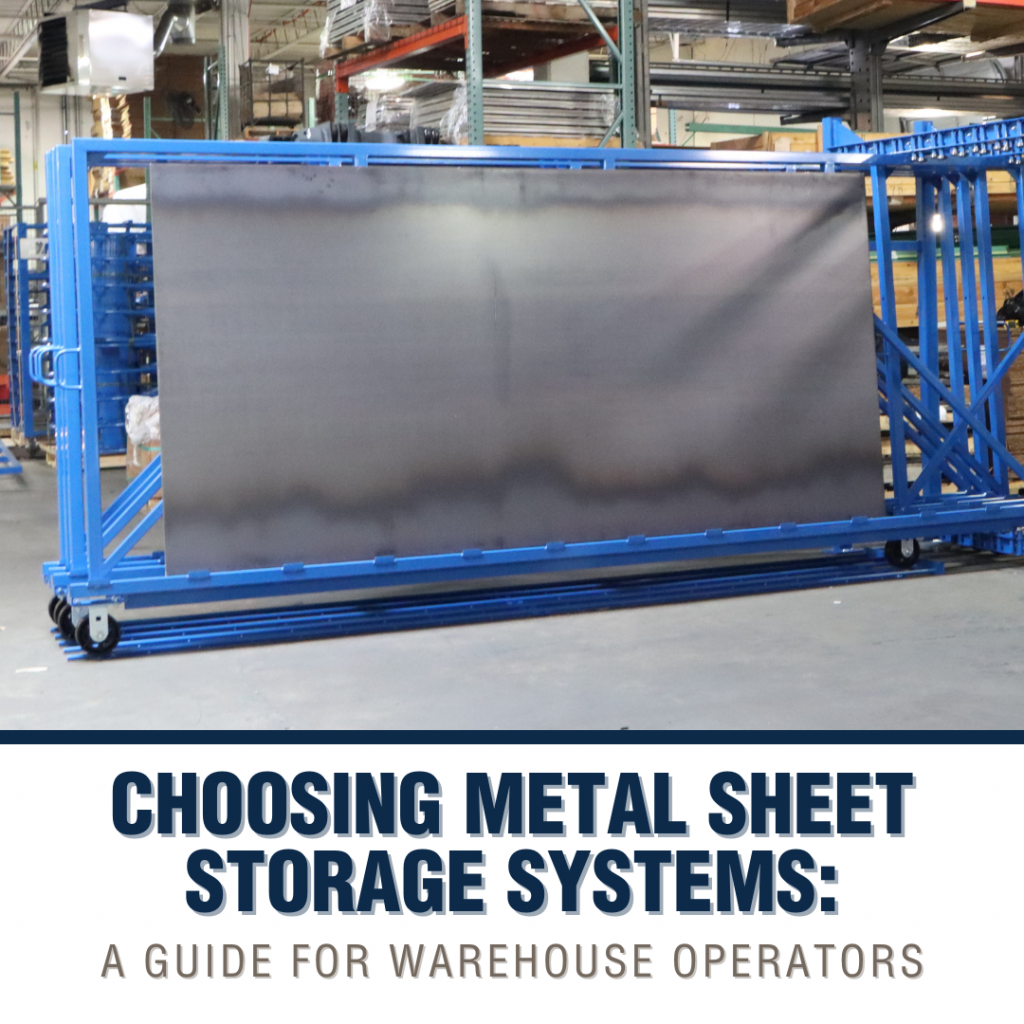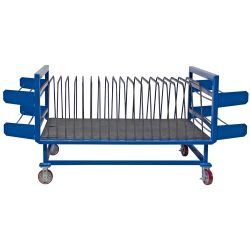We use cookies to make your experience better. To comply with the new e-Privacy directive, we need to ask for your consent to set the cookies. Learn more.
Choosing Metal Sheet Storage Systems: A Guide for Warehouse Operators
Sheet metal isn’t the easiest material to work with. It’s bulky, heavy, and lined with sharp edges. It’s hard to grip, which leads to a heightened risk of musculoskeletal injury during manual handling. Metal also conducts both heat and electricity, adding more hazards to contact between sheets and workers. To safely handle sheet metal at shops and warehouses, employers must have adequate safety controls in place.

Your sheet metal storage system can be one of these controls. A rack designed for easy access will eliminate some of the risks associated with handling sheet metal — and can also introduce other workplace benefits, including productivity gains. So while there’s a whole list of safety procedures for working with sheet metal (read about some of the relevant OSHA regulations here) in this article, we’ll focus on the starting point for all sheet metal projects: your metal sheet storage system.
Storage for Metal Sheets Vs. Coils of Sheet Metal
First off, it’s important to define what we mean by metal sheets. Metal materials include any of the metals typically used in industry; not just steel, but also aluminum, tin, copper, and more. You may even work with sheets of precious metals like gold, silver, and platinum.
Common sheet metals are also available in long strips coiled into enormous, heavy tubes. Handling strategies differ considerably between metal sheets and coils — and so do the storage systems that provide access to these materials. In this article, we’ll focus on sheet metal pressed into large, flat pieces, leaving metal coils for another post.
What to Look for in a Metal Sheet Storage System
How do you know which sheet metal rack is right for your facility? Evaluate the options according to these seven factors:
1. Safety
Stacking metal sheets on the ground creates a number of risks. Sharp edges can cause cuts and lacerations, so look for racking systems that limit such contact. Bending and lifting strains the back — and among laborers and material movers, more than 40 percent of job-related musculoskeletal disorders involved back injuries in 2016, says the Bureau of Labor Statistics. The ideal metal sheet storage system will be open to mechanical lifting devices. At the same time, it will elevate materials to prevent bending during manual access.
2. Capacity
Sheet metal overflow often ends up stacked next to racking systems, creating the very safety and productivity issues you’re trying to avoid. Choose a metal sheet storage system that offers enough capacity to handle your full inventory — ideally with some excess space for peak material flow.
Measure racking capacity not just in the size of sheets it can handle, but in terms of weight per rack. A 10-gauge (⅛-inch thickness) steel sheet weighs 5.487 pounds per square foot, so a single 24 by 48-inch steel sheet weighs nearly 44 pounds. If a rack offers just five inches of storage width per shelf, you could fit about 40 sheets of 10-gauge, 24-by-48-inch steel sheets per shelf — and you’d need a carrying capacity of at least 1,760 pounds per shelf for safe storage.
3. Product Protection
Metal sheet storage systems should protect product as well as workers. Racks that require you to slide sheets from a deep shelf increase the risk of scratches and wear on the metal during extraction, and shelves protruding burrs or unfinished metal can increase this risk. Vertical racks store sheets at an angle, primarily for stability — but with the added benefit that handlers can lean a sheet forward and avoid metal-on-metal sliding.
4. System Footprint
In any storage facility, space is value. Choose metal sheet storage systems that both fit into your existing infrastructure and limit storage footprint for efficient space usage. Roll-out shelving systems are best for meeting this goal; they keep metal sheets within a limited footprint while still offering easy access for material handling equipment, manual lifters, and reduced risk of product damage.
5. Inventory Organization
The longer you take to find the specific size and gauge of sheet metal you need to pick, the less throughput your facility can handle. You can certainly organize inventory in exposed sheet racks, both vertical and horizontal — but roll-out storage systems offer the advantage of clear labeling on shelf exteriors.
6. Compatibility with Material Handling Systems
“Whenever possible,” says an OSHA guide to working with sheet metal, “sheet metal should be moved mechanically.” Your racking systems must present sheets at an angle where material handling connectors have easy access, whether you use vacuum lifts, magnetic devices, sheet hoists, or forklifts. That doesn’t necessarily require a horizontal storage system, in which sheets lie flat, with an exposed face facing the ceiling. Roll-out vertical racking also presents the full surface of the sheet for simple access to most common sheet-handling devices.
7. Ease of Manual Access
Even with adequate material handling equipment in place, improving manual access to metal sheets improves flexibility within the facility. Some metal sheets may be small enough for safe manual access, which is often faster than using a lift — or the lift may be in use elsewhere, or down for repairs. To account for all material handling scenarios, look for sheet storage systems that provide simple manual access as well as mechanical lifting. That means a minimum of pulling or sliding of sheets during extraction from the system, another point in favor of roll-out racks.
Comparing Metal Sheet Storage Systems
Depending on throughput, common inventory, and material handling infrastructure, the ideal metal sheet storage solution will differ from one facility to the next. The main design features to consider include:
- Vertical vs. Horizontal Storage. Vertical sheet storage limits the system footprint compared to horizontal racking, which must be broad enough to support the full dimensions of sheets. It also keeps metal sheets at a standard height for better ergonomics during manual access, while horizontal systems may require bending to access lower sheets.
- Open vs. Roll-Out Design. Roll-out racking systems store sheets on extractable shelves seated within a frame, while open designs are static. There are advantages to each design; an open shelf skips the step of pulling out the shelf, but usually takes up more space and provides less protection to sheets.
- Cantilever vs. Shelf Racking. Cantilever racks store sheet materials on arms that extend out from a central frame, making contact with materials at as few as two points. Shelving systems provide more robust support, with a flat surface or a supported framework that makes contact across the full edge of the sheet. While either option may be appropriate for metal sheets, shelving offers more support and reduces the risk of dropping materials.
BHS, Inc. offers several solutions for high-capacity metal sheet storage. All of these products store sheet metal vertically for optimal space utilization — and these units are designed to support materials beyond metal, providing efficient storage (and access) for sheet materials from glass to wood to granite slabs. Options include:
Vertical Sheet Rack System
This is a full-service, high-density metal sheet storage solution. The Vertical Sheet Rack System fits rows of slightly angled vertical sheet racks into a steel, powder-coated frame. Racks roll in and out of the frame via stable tracks, allowing a single user to easily access materials within. These systems are configurable to match any application; choose any number of rolling shelves, with access to single units or trolleys of five units at a time.
Lateral support bars on the exterior of the frame provide convenient storage for sheet remnants, and ergonomic handles create easier access to each rolling shelf. Users can store a single sheet per shelf, or stack multiple sheets of lower-gauge metal for even higher-density storage. Shelves extend fully from the system for full-face access to sheets, creating easy access for vacuum lifts, cranes, forklifts, hoists, and manual lifting. The Vertical Sheet Rack System provides the greatest combination of space-saving, safety, ease of access, and protection for materials.
Learn more about BHS Vertical Sheet Rack Systems here.
Sheet Material Racks
These vertical, open-shelving racking systems store sheets on front-facing, gently angled shelves. Shelving surfaces are lined with an anti-skid rubber surface to protect materials while enhancing stability. Sides of the frame are removable to expand the size capacity of supported materials.
Sheet Material Racks are stackable up to three units high to limit footprint. They’re built to withstand heavy usage, with steel-tube frames, a durable powder-coat finish, and a carrying capacity of up to 8,000 pounds (though this differs for upper-level stacked units; contact us for details.)
Learn more about BHS Sheet Material Racks here.
Mobile Sheet Material Racks
Get the benefits of storage and material handling with a single unit. Mobile Sheet Material Racks split the difference between a cart and a storage system, with a series of steel supports spaced to keep products securely in place, at rest or during transit. A raised frame rests on heavy-duty phenolic casters, providing mobility and staging sheets for ergonomic manual access. The vertical-storage design creates a small storage footprint, while cart functionality reduces the risks of manual material handling for metal sheets.
Learn more about BHS Mobile Sheet Material Racks here.
Like all BHS products, these metal sheet storage solutions are available in custom configurations to match any application. Contact us for custom designs, or to learn more about sheet metal storage and handling solutions from BHS, Inc.

